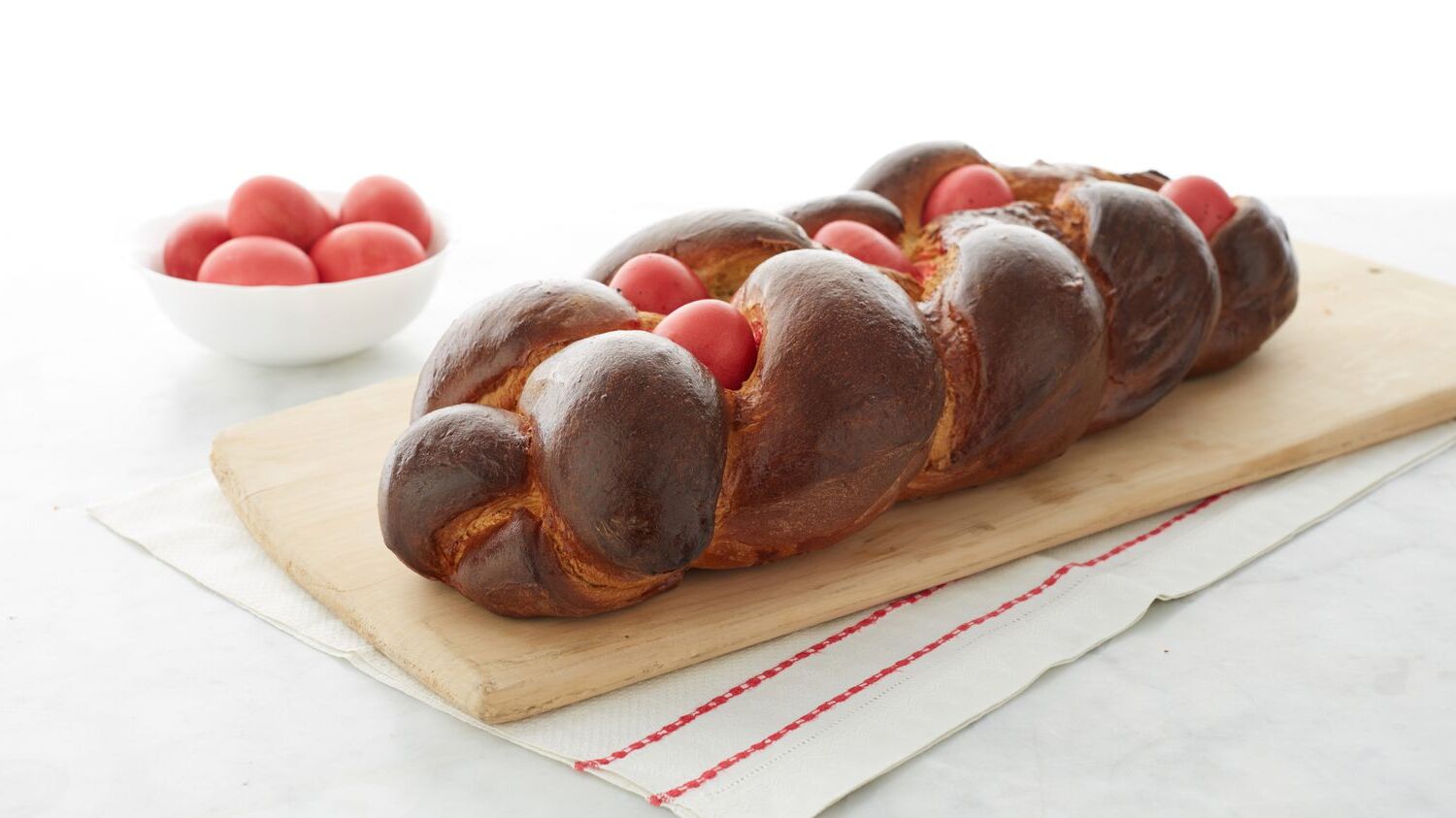Tsoureki is a traditional Greek Easter bread, known for its rich, slightly sweet flavor and distinctive braided shape. This festive bread is often enjoyed during Easter celebrations, symbolizing the resurrection of Christ. The unique combination of spices gives it a delightful aroma and taste, making it a favorite among many.
Some of the ingredients in this recipe may not be commonly found in every household. Mahlab and Mastic are two such ingredients. Mahlab is a spice made from the seeds of a specific type of cherry, and Mastic is a resin obtained from the mastic tree. Both can usually be found in specialty stores or online.

Ingredients for Tsoureki Greek Easter Bread
Flour: The base of the dough, providing structure and texture.
Sugar: Adds sweetness to the bread.
Milk: Used to activate the yeast and add moisture to the dough.
Eggs: Contribute to the richness and structure of the bread.
Yeast: The leavening agent that helps the dough rise.
Mahlab: A spice that adds a unique, slightly bitter cherry flavor.
Mastic: A resin that imparts a subtle pine or cedar-like flavor.
Butter: Adds richness and moisture to the dough.
Salt: Enhances the flavors of the other ingredients.
Vanilla extract: Adds a sweet, aromatic flavor.
Egg yolk: Used in the egg wash to give the bread a shiny, golden crust.
Water: Combined with the egg yolk for the egg wash.
Technique Tip for Making Tsoureki
When kneading the dough, ensure you use the heel of your hand to push the dough away from you, then fold it back over itself. This technique helps develop the gluten structure, making the bread light and airy. If the dough is too sticky, add a little more flour, but be careful not to add too much as it can make the bread dense.
Suggested Side Dishes
Alternative Ingredients
all-purpose flour - Substitute with bread flour: Bread flour has a higher protein content, which can give the bread a chewier texture, similar to traditional tsoureki.
sugar - Substitute with honey: Honey adds a different depth of sweetness and moisture, which can enhance the flavor of the bread.
warm milk - Substitute with warm almond milk: Almond milk can be used for those who are lactose intolerant or prefer a dairy-free option.
large room temperature eggs - Substitute with flax eggs: Flax eggs (1 tablespoon ground flaxseed mixed with 3 tablespoon water per egg) can be used as a vegan alternative.
active dry yeast - Substitute with instant yeast: Instant yeast can be used in the same quantity and does not need to be dissolved in water first.
ground mahlab - Substitute with ground cardamom: Cardamom has a similar aromatic quality and can provide a comparable flavor profile.
ground mastic - Substitute with vanilla bean paste: Vanilla bean paste can add a rich, aromatic flavor, though it will be different from the unique taste of mastic.
melted unsalted butter - Substitute with coconut oil: Coconut oil can be used as a dairy-free alternative and adds a slight coconut flavor.
salt - Substitute with sea salt: Sea salt can be used in the same quantity and provides a slightly different mineral content.
vanilla extract - Substitute with almond extract: Almond extract offers a different but complementary flavor that can enhance the overall taste of the bread.
large egg yolk - Substitute with milk: Brushing the bread with milk can give a similar golden-brown finish without using eggs.
water - Substitute with milk: Using milk instead of water in the egg wash can add a bit more richness and help with browning.
Other Alternative Recipes Similar to This Greek Easter Bread
How to Store or Freeze This Greek Easter Bread
- To keep your Tsoureki fresh, store it in an airtight container at room temperature. This will maintain its soft and fluffy texture for up to 3 days.
- For longer storage, wrap the bread tightly in plastic wrap and then place it in a resealable plastic bag. This method will keep it fresh for up to a week.
- If you want to freeze the Tsoureki, first let it cool completely. Then, wrap it in plastic wrap and place it in a heavy-duty freezer bag. It can be frozen for up to 3 months.
- When you're ready to enjoy your frozen Tsoureki, thaw it at room temperature. For a freshly baked taste, warm it in a preheated oven at 300°F (150°C) for about 10 minutes.
- If you prefer individual servings, slice the bread before freezing. Wrap each slice in plastic wrap and store them in a freezer bag. This way, you can thaw and enjoy one slice at a time without defrosting the entire loaf.
- To prevent the bread from drying out, avoid refrigerating it. The cold temperature can cause the bread to become stale faster.
- For an extra touch of flavor, consider brushing the Tsoureki with a light syrup made from sugar and water before storing. This will keep it moist and add a delightful sweetness.
How to Reheat Leftovers
Preheat your oven to 300°F (150°C). Wrap the tsoureki in aluminum foil to prevent it from drying out. Place it on a baking sheet and heat for about 10-15 minutes, or until warmed through.
For a quick reheat, slice the tsoureki and place the slices on a microwave-safe plate. Cover with a damp paper towel to retain moisture. Microwave on medium power for 20-30 seconds, checking frequently to avoid overheating.
Use a toaster oven for a crispier texture. Set the toaster oven to 300°F (150°C) and place the slices directly on the rack or on a baking sheet. Heat for 5-7 minutes, or until the tsoureki is warm and slightly crispy.
If you have a steamer, wrap the tsoureki in parchment paper and steam for about 5 minutes. This method helps retain the bread's moisture and softness.
For a stovetop method, heat a non-stick skillet over low heat. Place slices of tsoureki in the skillet and cover with a lid. Heat for 2-3 minutes on each side, or until warmed through. This method can give a slight crisp to the exterior while keeping the inside soft.
Best Tools for Making Tsoureki
Small bowl: Used to dissolve the yeast in warm milk.
Large mixing bowl: Used to combine the flour, sugar, mahlab, mastic, and salt.
Measuring cups: Used to measure out the flour, sugar, and milk.
Measuring spoons: Used to measure out the yeast, mahlab, mastic, salt, and vanilla extract.
Whisk: Used to whisk together the egg yolk and water for the egg wash.
Wooden spoon: Used to mix the yeast mixture, eggs, melted butter, and vanilla extract into the dry ingredients.
Floured surface: Used to knead the dough until smooth and elastic.
Greased bowl: Used to let the dough rise.
Damp cloth: Used to cover the dough while it rises.
Baking sheet: Used to place the braided dough on for baking.
Oven: Used to bake the tsoureki at 350°F (175°C).
Wire rack: Used to cool the baked tsoureki before serving.
Pastry brush: Used to brush the egg wash over the braided dough.
How to Save Time on Making This Greek Easter Bread
Prepare ingredients ahead: Measure and set out all ingredients before starting. This saves time and ensures you have everything ready.
Use a stand mixer: If you have a stand mixer, use it to mix and knead the dough. It speeds up the process and ensures even mixing.
Warm environment: Let the dough rise in a warm place, like an oven with the light on. This speeds up the rising process.
Preheat oven early: Start preheating the oven while the dough is rising to save time.
Make extra: Double the recipe and freeze extra loaves for future use.

Tsoureki Greek Easter Bread Recipe
Ingredients
Main Ingredients
- 4 cups all-purpose flour
- 1 cup sugar
- 1 cup milk warm
- 3 large eggs room temperature
- 1 tablespoon active dry yeast
- 1 teaspoon mahlab ground
- 1 teaspoon mastic ground
- ½ cup unsalted butter melted
- 1 teaspoon salt
- 1 teaspoon vanilla extract
- 1 large egg yolk for egg wash
- 1 tablespoon water for egg wash
Instructions
- In a small bowl, dissolve yeast in warm milk. Let it sit for 10 minutes until frothy.
- In a large mixing bowl, combine flour, sugar, mahlab, mastic, and salt.
- Add the yeast mixture, eggs, melted butter, and vanilla extract to the dry ingredients. Mix until a dough forms.
- Knead the dough on a floured surface for about 10 minutes until smooth and elastic.
- Place the dough in a greased bowl, cover with a damp cloth, and let it rise in a warm place for about 1.5 hours or until doubled in size.
- Preheat the oven to 350°F (175°C). Punch down the dough and divide it into three equal parts. Braid the dough and place it on a baking sheet.
- In a small bowl, whisk together the egg yolk and water. Brush the egg wash over the braided dough.
- Bake for 25-30 minutes or until golden brown. Let it cool on a wire rack before serving.
Nutritional Value
Keywords
Suggested Appetizers and Main Courses for This Greek Easter Bread
More Amazing Recipes to Try 🙂
- Burger or Hot Dog Buns Recipe35 Minutes
- Fennel Seed and Orange Peel Bread Recipe1 Hours
- Cereal Bread Recipe1 Hours
- Drop Biscuits Recipe25 Minutes
- Dutch Oven Caraway Rye Bread Recipe1 Hours 5 Minutes
- Puff Pastry Recipe50 Minutes
- Butter Swim Biscuits Recipe35 Minutes
- Lemon Zucchini Bread Recipe1 Hours 5 Minutes

Leave a Reply